
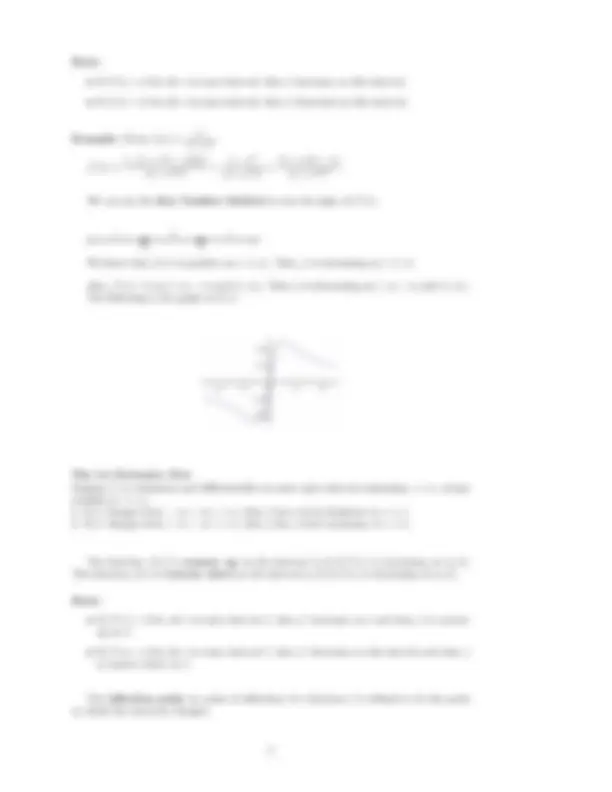
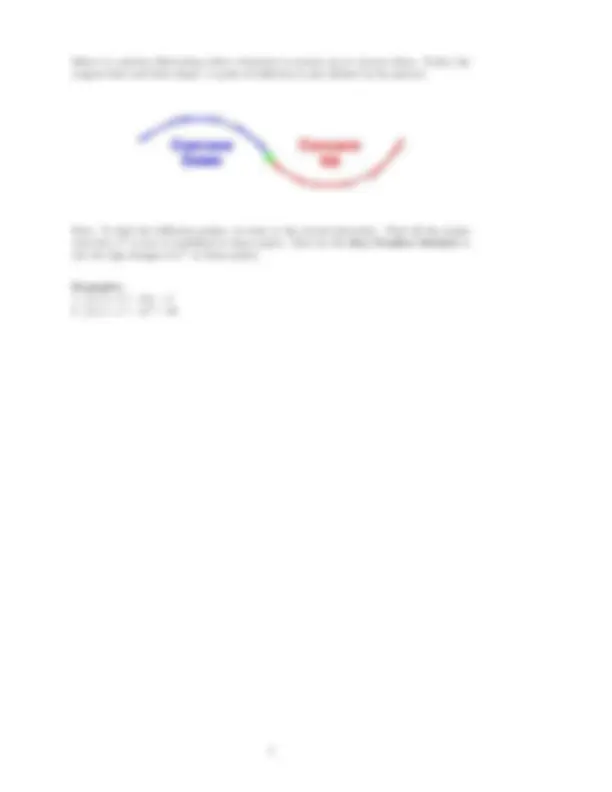
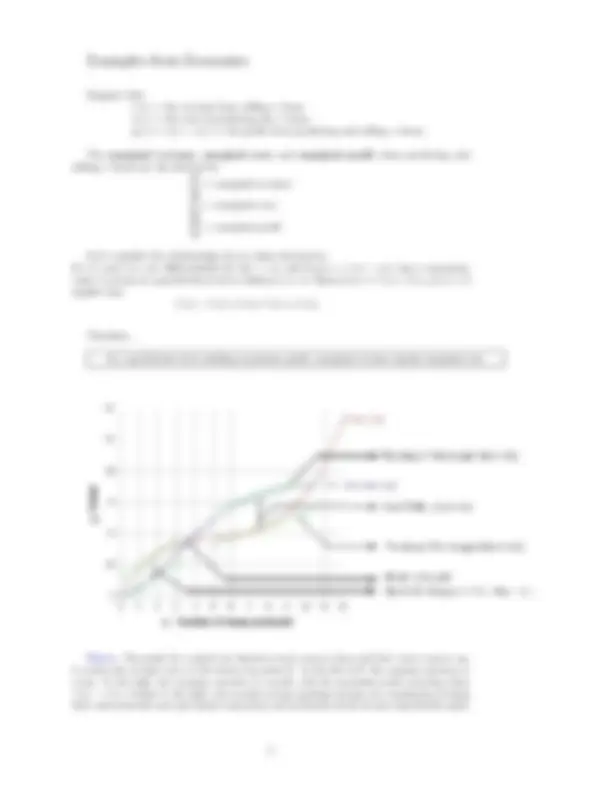
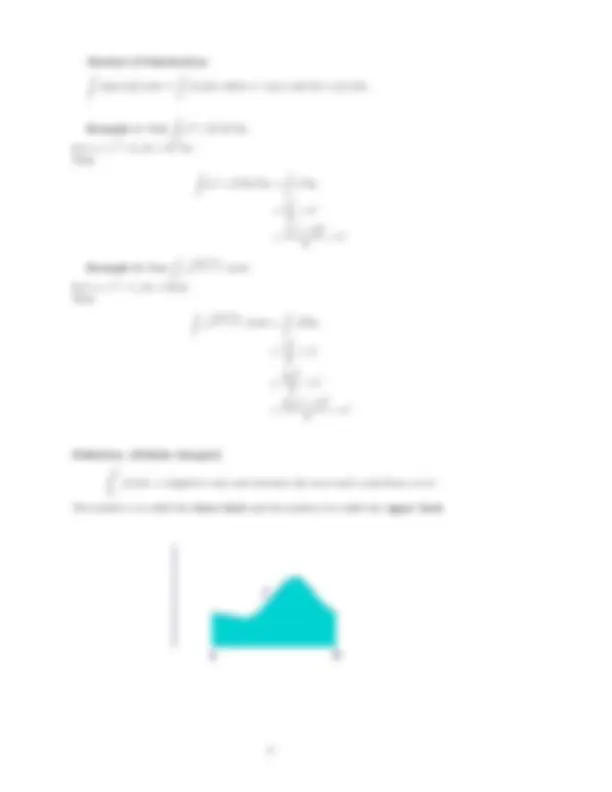
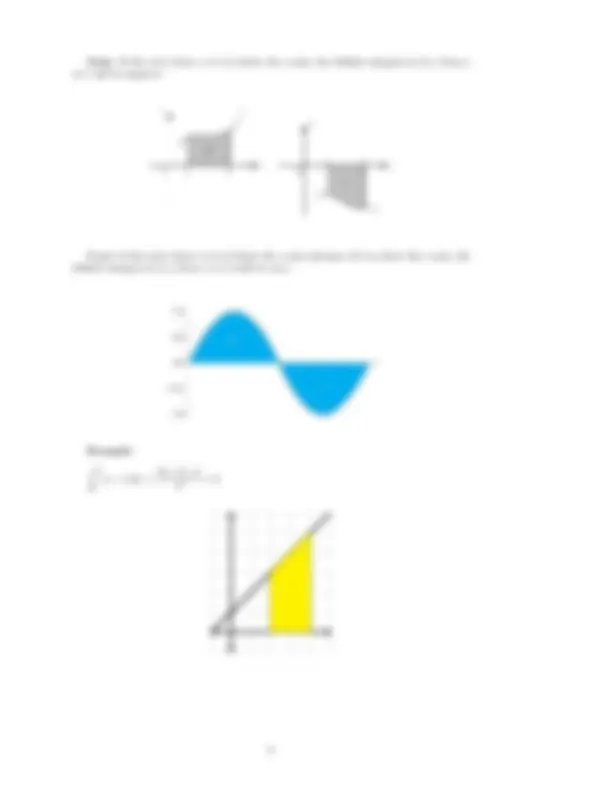
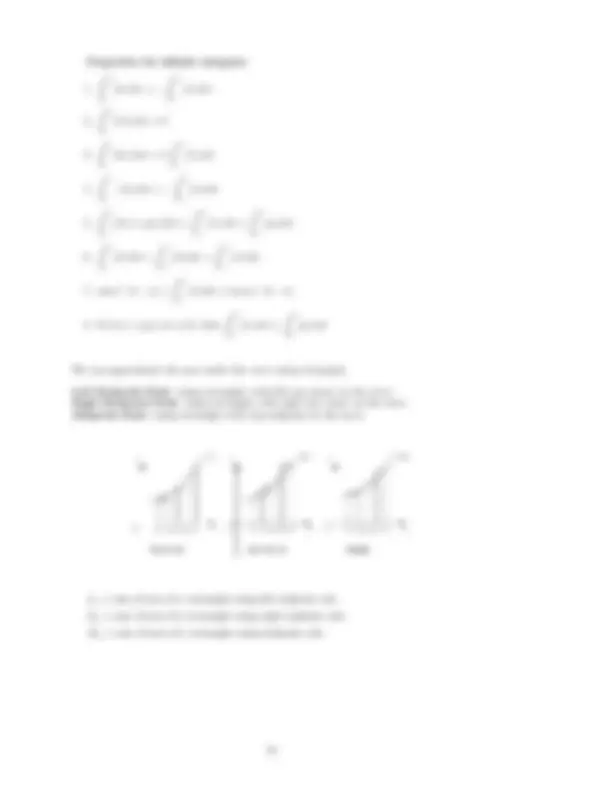


Study with the several resources on Docsity

Earn points by helping other students or get them with a premium plan


Prepare for your exams
Study with the several resources on Docsity

Earn points to download
Earn points by helping other students or get them with a premium plan
Community
Ask the community for help and clear up your study doubts
Discover the best universities in your country according to Docsity users
Free resources
Download our free guides on studying techniques, anxiety management strategies, and thesis advice from Docsity tutors
The concepts of derivatives and integration, including the definitions of derivatives, rules for finding derivatives, the concept of the second derivative, and the relationship between derivatives and integrals. The document also includes examples and applications of these concepts in various contexts.
What you will learn
Typology: Study Guides, Projects, Research
1 / 12

This page cannot be seen from the preview
Don't miss anything!







A tangent line to a function at a point is the line that best approximates the function at that point better than any other line.
The slope of the function at a given point is the slope of the tangent line to the function at that point.
The derivative of f at x = a is the slope, m, of the function f at the point x = a (if m exists), denoted by f ′(a) = m. All other notations:
y′, dydx , dfdx , (^) dxd f (x), Dxy, Dxf (x).
The function f (x) is differentiable at a point x 0 if f ′(x 0 ) exists. If a function is differentiable at all points in its domain (i.e. f ′(x) is defined for all x in the domain), then we consider f ′(x) as a function and call it the derivative of f (x).
The derivative of f that we have been talking about is called the first derivative. Now, we define the second derivative of a function to be the derivative of f ′, denoted by f ′′(x)
or d
(^2) f dx^2 (=^
d dx
( (^) d dx f^ )
Example 1: Given f (x) = c where c is a constant. Then f ′(x) = 0 because the slope of the function at each point is zero.
Example 2: If f (x) = 2 − 3 x , then the derivative f ′(x) = 2 because the slope of the function at each point is 2.
Example 3: Given f (x) = |x|. We have
f ′(x) =
− 1 if x < 0 1 if x > 0
However, f ′(0) is not defined because there is no unique tangent line to f (x) at x = 0.
The following is a table of derivatives of some basic functions:
f (x) f ′(x) c 0 mx + c m xa^ axa−^1 ex^ ex ln x (^) x^1
Rules of Differentiation:
f g
f ′g − f g′ g^2
(where g(x) 6 = 0)
The equation of the tangent line to the function at point x = x 0 is:
y − f (x 0 ) = f ′(x 0 )(x − x 0 )
Theorem (The Extreme-Value Theorem for Continuous Functions) If f is continuous at every point of a closed interval I, then f assumes both an absolute maximum value value M and an absolute minimum value m somewhere in I.
Definition A point in the domain of a function f at which f ′^ = 0 or f ′^ does not exist is a critical point of f.
Theorem Extreme values (local or global) occur only at critical points and endpoints.
Examples:
Theorem (The Mean Value Theorem) Suppose the f (x) is continuous on a closed interval [a, b] and differentiable on the interval’s interior (a, b). Then there is at least one point c in (a, b) at which
f (b) − f (a) b − a
= f ′(c).
Below is a picture illustrating when a function is concave up or concave down. Notice the tangent lines and their slopes. A point of inflection is also labeled on the picture.
Note: To find the inflection points, we look at the second derivative. Find all the points such that f ′′^ is zero or undefined at those points. Then use the Key Number Method to test the sign changes of f ′′^ at those points.
Examples:
Suppose that r(x) = the revenue from selling x items c(x) = the cost of producing the x items p(x) = r(x) − c(x) = the profit from producing and selling x items.
The marginal revenue, marginal cost, and marginal profit when producing and selling x items are the derivatives dr dx
= marginal revenue, dc dx
= marginal cost, dp dx
= marginal profit.
Let’s consider the relationship of p to these derivatives. If r(x) and c(x) are differentiable for all x > 0, and if p(x) = r(x) − c(x) has a maximum value, it occurs at a production level at which p′(x) = 0. Since p′(x) = r′(x)−c′(x), p′(x) = 0 implies that r′(x) − c′(x) = 0 or r′(x) = c′(x).
Therefore,
At a production level yielding maximum profit, marginal revenue equals marginal cost.
Figure. The graph of a typical cost function starts concave down and later turns concave up. It crosses the revenue curve at the break-even point B. To the left of B, the company operates at a loss. To the right, the company operates at a profit, with the maximum profit occurring where c′(x) = r′(x). Farther to the right, cost exceeds revenue (perhaps because of a combination of rising labor and materials costs and market saturation) and production levels become unprofitable again.
Mean Value Theorem Suppose f (x) is continuous on [a, b] and differentiable on (a, b). Then there exists a point c in (a, b) at which
f (b) − f (a) b − a
= f ′(c). (1)
Corollary 1 If f ′(x) = 0 at each point of an interval I, then f (x) = C for all x in I, where C is a constant.
Corollary 2 If f ′(x) = g′(x) at each point of an interval I, then there exists a constant C such that f (x) = g(x) + C for all x in I.
A function, F (x), is an antiderivative of a function f (x) if F ′(x) = f (x) for all x in the domain of f.
Example: The function F (x) = x^2 is an antiderivative of f (x) = 2x. The function G(x) = x^2 + 4 is also an antiderivative of f (x) = 2x.
The set of all antiderivative of f is the indefinite integral of f with respect to x, denoted by (^) ∫
f (x)dx
The symbol
is an integral sign. The function f (x) is the integrand of the integral, and x is the variable of integration.
To verify
xexdx = xex^ − ex^ + C, we take the derivative of the right hand side. d dx
xex^ − ex^ + C = ex^ + xex^ − ex^ = xex. Thus, the integral statement is correct.
∫ Integral formulas xndx =
xn+ n + 1
dx = x + C ∫ exdx = ex^ + C ∫ 1 x
dx = ln |x| + C
Rules for indefinite integrals:
kf (x)dx = k
f (x)dx
−f (x)dx = −
f (x)dx
[f (x) ± g(x)]dx =
f (x)dx ±
g(x)dx
Method of Substitution: ∫ f (g(x))g′(x)dx =
f (u)du where u = g(x) and du = g′(x)dx.
Example 1: Find
(x^3 + 2)^53 x^2 dx.
Let u = x^3 + 2, du = 3x^2 dx. Then ∫ (x^3 + 2)^53 x^2 dx =
u^5 du
u^6 6
(x^3 + 2)^6 6
Example 2: Find
x^2 + 1 · 2 xdx.
Let u = x^2 + 1, du = 2xdx. Then ∫ (^) √ x^2 + 1 · 2 xdx =
udu
u (^32) 3 2
2 u (^32)
3
2(x^2 + 1) (^32)
3
Definition: (Definite Integral)
∫ (^) b
a
f (x)dx = (signed or net) area between the curve and x-axis from a to b.
The number a is called the lower limit and the number b is called the upper limit.
Properties for definite integrals:
∫ (^) b
a
f (x)dx = −
∫ (^) a
b
f (x)dx
∫ (^) a
a
kf (x)dx = 0
∫ (^) b
a
kf (x)dx = k
∫ (^) b
a
f (x)dx
∫ (^) b
a
−f (x)dx = −
∫ (^) b
a
f (x)dx
∫ (^) b
a
[f (x) ± g(x)]dx =
∫ (^) b
a
f (x)dx ±
∫ (^) b
a
g(x)dx
∫ (^) b
a
f (x)dx +
∫ (^) c
b
f (x)dx =
∫ (^) c
a
f (x)dx
∫ (^) b
a
f (x)dx ≤ max f · (b − a)
∫ (^) b
a
f (x)dx ≥
∫ (^) b
a
g(x)dx
We can approximate the area under the curve using rectangles.
Left Endpoint Rule: using rectangles with left top corner on the curve Right Endpoint Rule: using rectangles with right top corner on the curve Midpoint Rule: using rectangles with top midpoint on the curve
Ln = sum of area of n rectangles using left endpoint rule. Rn = sum of area of n rectangles using right endpoint rule. Mn = sum of area of n rectangles using midpoint rule.
The Fundamental Theorem of Calculus (Part 1) Let f be a continuous function on [a, b]. Let F be the function
F (x) =
∫ (^) x
a
f (t)dt.
Then, F (x) is continuous on [a, b], differentiable on (a, b) and
dF dx
d dx
∫ (^) x
a
f (t)dt = f (x).
(Part 2) If f is a continuous function on [a, b] and F is any antiderivative of f on [a,b], then
∫ (^) b
a
f (t)dt = F (b) − F (a) := F (x)
b a
Example 1:
d dx
∫ (^) x
1
t^2 + 3dt =
x^2 + 3
Example 2:
d dx
∫ (^) x^2
3
tetdt = x^2 ex
2 · (2x) = 2x^3 ex
2
Example 3: ∫ (^2)
1
(3x^2 + 2x)dx = x^3 + x^2
2 1
Example 4: ∫ (^2)
0
2 x
x^2 + 1dx
First find an antiderivative of 2x
x^2 + 1. ∫ 2 x
x^2 + 1dx
Let u = x^2 + 1, du = 2xdx.
Then
2 x
x^2 + 1dx =
udu =
2 u (^32)
3
2(x^2 + 1) (^32)
3
Thus,
0
2 x
x^2 + 1dx =
2(x^2 + 1) (^32)
3
1 0
(^32)
3